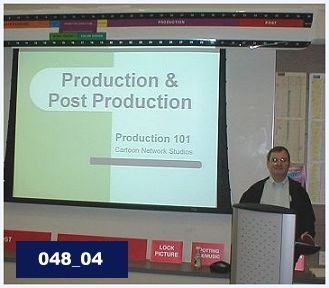cataroo.com
Home of John Cawley
Dedicated to My Wife & Times - A Site for Sore Eyes
Back To Archives
Back To Main Page
|
Frames of Time... 048_04 - Animated Seminars I first got interested in the history of animation in the early 1970s. This led me to do a lot of research, since, at that time, there were very few books about the subject. The ones that were around were usually either about Disney or European art films. Hence I spent hours at the Cal State University Long Beach Library going through articles, clipping files and microfilm. All of that work led me to eventually be the resident expert. I assisted the film criticism class by providing a talk on animation when they showed DUMBO. That was so popular, I was asked to create a weekend seminar for the University Honors Program. Eventually it culminated in me teaching a class on the history and culture of animation. Outside of college, I found myself on a number of panels at comic conventions. Topics ranged from where to buy animation on 8mm (before the home video boom of the late 1980s), how animation is created, the future of prime time animation and the future of animated features. I made the mistake on the last one of correcting a major director on some of his facts. It was the last panel I got invited to. (I had long learned never to correct your boss, but I thought panelists were less powerful, and audiences were more interested in facts than theories and urban legends.) When I was at Don Bluth, the studio sent me to various trade shows and conventions. Don once stated, "John knows more about animation than anyone else I've ever met". Whether it was at videogame trade shows or comic conventions, Don would set me up where I could talk about the elaborate process to create the videogames DRAGON'S LAIR and SPACE ACE, as well as the historic nature of the productions. While at Film Roman, I received a call from Peter Schneider for a private audience. He had just been put in charge of the animated feature division and wanted some information. Peter began the talk be saying there was "no executive job" at Disney, since that was what he had been hired for. Instead, he had asked around for the names of top production folks that he could talk to to better understand how animation is done. It seems I had been one of three recommended by his contacts. He had then gotten around to ask each of us in to talk about how animation is produced. Our discussion mostly consisted of him asking about "rumors" he had heard and whether they were true or not. One I remember is that he had been told you could not produce an animated feature with less than three directors. I stated that was false and gave numerous examples. He had also been told that anyone who wrote for live-action would not be able to contribute to an animated film due to the writer's lack of vision. Though I have still done some minor talks here and there, my recent talks at Cartoon Network have been particularly fulfilling. It is fun to watch an accountant; a lawyer and even a producer suddenly grasp why a particular process is important or where a term is derived from. After the talks, it is rewarding to have the folks come up and thank me for explaining the process and business side. (Yes, I talk production and business so that the audience can link the two.) At the recent event, the other producer asked if I was at all nervous. I shook my head no and said, "Not at all. I know the topic fully, and I love talking about animation." Heck, ask anyone who sticks his or her head in my office at the studio with a question. In fact, I have to check myself regularly to keep from telling more than was asked.
Back To Archives Back To Main Page |
 I recently got back from Atlanta, where I was one of two producers from Cartoon Network Studios discussing the process of animation to executives and interested parties at the home of Turner networks. In some ways it was like old times.
I recently got back from Atlanta, where I was one of two producers from Cartoon Network Studios discussing the process of animation to executives and interested parties at the home of Turner networks. In some ways it was like old times.